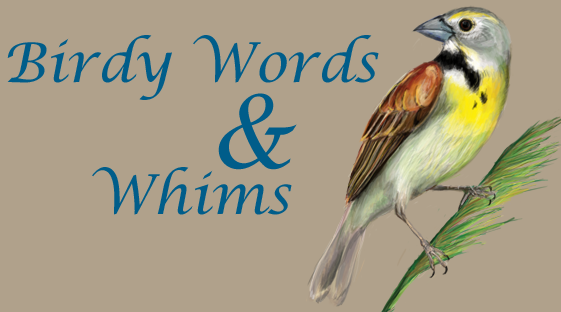 This morning started out very windy and a slow day for birds. There was plenty of activity among the beautiful prairie blooms, but none of the birds were flying into the nets. Pictured above are a pair of Red-winged blackbirds. Most likely this pair is nesting in the grass below since they were being rather loud as I walked by. It's pretty neat seeing the same birds returning to the same nest locations a year later. Not that we can tell for sure, but the same species seem to return to the same spots and I remember a pair of blackbirds nesting in this spot last summer.
This morning started out very windy and a slow day for birds. There was plenty of activity among the beautiful prairie blooms, but none of the birds were flying into the nets. Pictured above are a pair of Red-winged blackbirds. Most likely this pair is nesting in the grass below since they were being rather loud as I walked by. It's pretty neat seeing the same birds returning to the same nest locations a year later. Not that we can tell for sure, but the same species seem to return to the same spots and I remember a pair of blackbirds nesting in this spot last summer. Although the hours seemed to drag by without any birds, we ended up catching a few of the old favorites, Song Sparrows, Common Yellowthroats (the male pictured above), and a pair of Catbirds. We also wound up with a few very awesome surprises!
Although the hours seemed to drag by without any birds, we ended up catching a few of the old favorites, Song Sparrows, Common Yellowthroats (the male pictured above), and a pair of Catbirds. We also wound up with a few very awesome surprises!  Here is the bird of the day! I was really stumped when I saw him. A green bird with a black face flying all over the prairie and warbling away in the trees. We finally identified it as a first year male Orchard Oriole. I'm sure I have never seen one with this plumage before, but I think it was a pretty good match after checking the guidebook several times over. The mature male Orchard Oriole is very reminiscent of the male Baltimore Oriole, but with a reddish brown tint instead of orange. This male is in the awkward transition phase of life where his plumage actually resembles the greenish-colored female more closely than the male. A young adult baltimore oriole would be more orangey-yellow and singing a very different tune. Check the video to hear the Orchard Oriole's song.
Here is the bird of the day! I was really stumped when I saw him. A green bird with a black face flying all over the prairie and warbling away in the trees. We finally identified it as a first year male Orchard Oriole. I'm sure I have never seen one with this plumage before, but I think it was a pretty good match after checking the guidebook several times over. The mature male Orchard Oriole is very reminiscent of the male Baltimore Oriole, but with a reddish brown tint instead of orange. This male is in the awkward transition phase of life where his plumage actually resembles the greenish-colored female more closely than the male. A young adult baltimore oriole would be more orangey-yellow and singing a very different tune. Check the video to hear the Orchard Oriole's song. Here's a look at what we deal with when we take birds out of the nets. Sometimes it's really hard to tell which way they actually came into the net. It can get worse the more they struggle since they can become tangled in several layers of the net. In severe cases we can cut the nets to untangle the bird, but we try to avoid it since it will be much easier for a bird to escape in a cut up net. But in most cases, such as for this Song Sparrow, we can get them out in 2 minutes or less.
Here's a look at what we deal with when we take birds out of the nets. Sometimes it's really hard to tell which way they actually came into the net. It can get worse the more they struggle since they can become tangled in several layers of the net. In severe cases we can cut the nets to untangle the bird, but we try to avoid it since it will be much easier for a bird to escape in a cut up net. But in most cases, such as for this Song Sparrow, we can get them out in 2 minutes or less.
I just can't get enough of brilliant blue birds so I have to share another one with you, an Indigo Bunting singing in the prairie. We had indigo buntings in surround sound today everywhere we went, but they are still pretty good at avoiding our nets.
On my way home, I had another birdy surprise, a pair of Sandhill Cranes literally a block away from my apartment. Although the cranes are regulars to the marsh and the prairie not far away, I guess I just wasn't expecting to see them on the lawn of the "Cereal Crops Research Unit."For those of you interested in flowers, I have a few pictures of prairie blooms. I couldn't tell you what they are called though. Second picture - Purple coneflowers I think?
Birds Banded: Grey Catbird (2), Song Sparrow, Common Yellowthroat, American Robin, Eastern Bluebird
 Birdy Artwork: Tufted Titmouse
Birdy Artwork: Tufted Titmouse







 This morning was a slow day for banding at Biocore Prairie. We only had five birds and closed up early around 11am. The highlight though was a pair of Cedar Waxwings. We have them out on the prairie on a regular basis but they usually fly too high to get caught in the nets. Two were extremely busy this morning collecting nest material, and eyeing our nets for loose strands. Only a few minutes after I said how much I wanted to band one, we caught them.
This morning was a slow day for banding at Biocore Prairie. We only had five birds and closed up early around 11am. The highlight though was a pair of Cedar Waxwings. We have them out on the prairie on a regular basis but they usually fly too high to get caught in the nets. Two were extremely busy this morning collecting nest material, and eyeing our nets for loose strands. Only a few minutes after I said how much I wanted to band one, we caught them.







 Here is a picture of one of our nets that we set up and take down each time we band. This is the one nearby the catbird nest.
Here is a picture of one of our nets that we set up and take down each time we band. This is the one nearby the catbird nest. 
 Another view of a banded catbird, and a good look at that catbird characteristic red rump, or probably more appropriately known as "rusty undertail coverts."
Another view of a banded catbird, and a good look at that catbird characteristic red rump, or probably more appropriately known as "rusty undertail coverts."


 I love all the details and decoration on this bird, it's almost like a piece of modern art. The plumage may be showy, but there are actually not many differences between the sexes in this bird. This Flicker is also known as a "Yellow-shafted Flicker" which is a sub-species. The Yellow-shafted and red-shafted used to be thought of as two separate species, but they often interbreed. If you see this bird in flight, look for red or yellow on the underwings. All of the Flickers I've seen at Biocore Prairie have yellow shafted wing feathers like this one, but I believe it's still possible to see the red-shafted variation somewhere around here.
I love all the details and decoration on this bird, it's almost like a piece of modern art. The plumage may be showy, but there are actually not many differences between the sexes in this bird. This Flicker is also known as a "Yellow-shafted Flicker" which is a sub-species. The Yellow-shafted and red-shafted used to be thought of as two separate species, but they often interbreed. If you see this bird in flight, look for red or yellow on the underwings. All of the Flickers I've seen at Biocore Prairie have yellow shafted wing feathers like this one, but I believe it's still possible to see the red-shafted variation somewhere around here.

